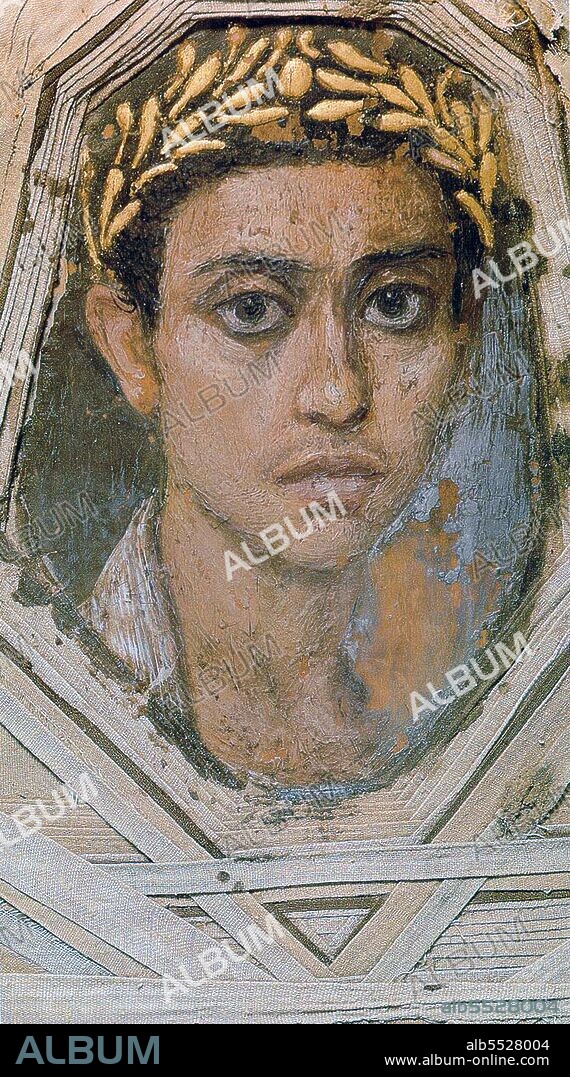alb5528004
Egypt: Mummy portrait of a young man, c. 3rd century CE.

|
Zu einem anderen Lightbox hinzufügen |
|
Zu einem anderen Lightbox hinzufügen |



Haben Sie bereits ein Konto? Anmelden
Sie haben kein Konto? Registrieren
Dieses Bild kaufen

Titel:
Egypt: Mummy portrait of a young man, c. 3rd century CE.
Untertitel:
Automatische Übersetzung: Mumienporträts oder Fayum-Mumienporträts (auch Fayum-Mumienporträts) ist die moderne Bezeichnung für eine Art naturalistisch gemalter Porträts auf Holzbrettern, die an Mumien aus der koptischen Zeit befestigt sind. Sie gehören zur Tradition der Tafelmalerei, einer der angesehensten Kunstformen der klassischen Welt. Tatsächlich sind die Fayum-Porträts das einzige große Kunstwerk aus dieser Tradition, das überlebt hat. Mumienporträts wurden in ganz Ägypten gefunden, sind aber im Fayum-Becken am häufigsten, insbesondere in Hawara und Antinoopolis, daher der gebräuchliche Name. „Fayum-Porträts“ wird im Allgemeinen als stilistische und nicht als geografische Beschreibung angesehen. Während bemalte Mumienhüllen aus Kartonage bis in die Zeit der Pharaonen zurückreichen, waren die Fayum-Mumienporträts eine Innovation aus der koptischen Zeit zur Zeit der römischen Besetzung Ägyptens. Sie stammen aus der Römerzeit, ab dem späten 1. Jahrhundert v. Chr. oder dem frühen 1. Jahrhundert n. Chr. Es ist nicht klar, wann ihre Produktion endete, aber neuere Forschungen deuten auf die Mitte des 3. Jahrhunderts hin. Sie gehören zu den größten Gruppen unter den sehr wenigen Überlebenden der hoch angesehenen Tafelmalereitradition der klassischen Welt, die in der postklassischen Welt in byzantinischen und westlichen Traditionen fortgeführt wurde, einschließlich der lokalen Tradition der koptischen Ikonographie in Ägypten
Mummy portraits or Fayum mummy portraits (also Faiyum mummy portraits) is the modern term given to a type of naturalistic painted portraits on wooden boards attached to mummies from the Coptic period. They belong to the tradition of panel painting, one of the most highly regarded forms of art in the Classical world. In fact, the Fayum portraits are the only large body of art from that tradition to have survived. Mummy portraits have been found across Egypt, but are most common in the Faiyum Basin, particularly from Hawara and Antinoopolis, hence the common name. 'Faiyum Portraits' is generally thought of as a stylistic, rather than a geographic, description. While painted Cartonnage mummy cases date back to pharaonic times, the Faiyum mummy portraits were an innovation dating to the Coptic period at the time of the Roman occupation of Egypt. They date to the Roman period, from the late 1st century BCE or the early 1st century CE onwards. It is not clear when their production ended, but recent research suggests the middle of the 3rd century. They are among the largest groups among the very few survivors of the highly prestigious panel painting tradition of the classical world, which was continued into Byzantine and Western traditions in the post-classical world, including the local tradition of Coptic iconography in Egypt.
Bildnachweis:
Album / Pictures from History/Universal Images Group
Freigaben (Releases):
Model: Nein - Eigentum: Nein
Rechtefragen?
Rechtefragen?
Bildgröße:
2838 x 5100 px | 41.4 MB
Druckgröße:
24.0 x 43.2 cm | 9.5 x 17.0 in (300 dpi)
Schlüsselwörter:
AEGYPTEN • AEGYPTISCH • AFRIKA • AFRIKANER • AFRIKANERIN • AFRIKANISCH • EGYPTISCH • GESCHICHTE • IKONOGRAPHIE • KUNST • ZEITGESCHICHTE • ÄGYPTEN
 Pinterest
Pinterest Twitter
Twitter Facebook
Facebook Link kopieren
Link kopieren Email
Email
